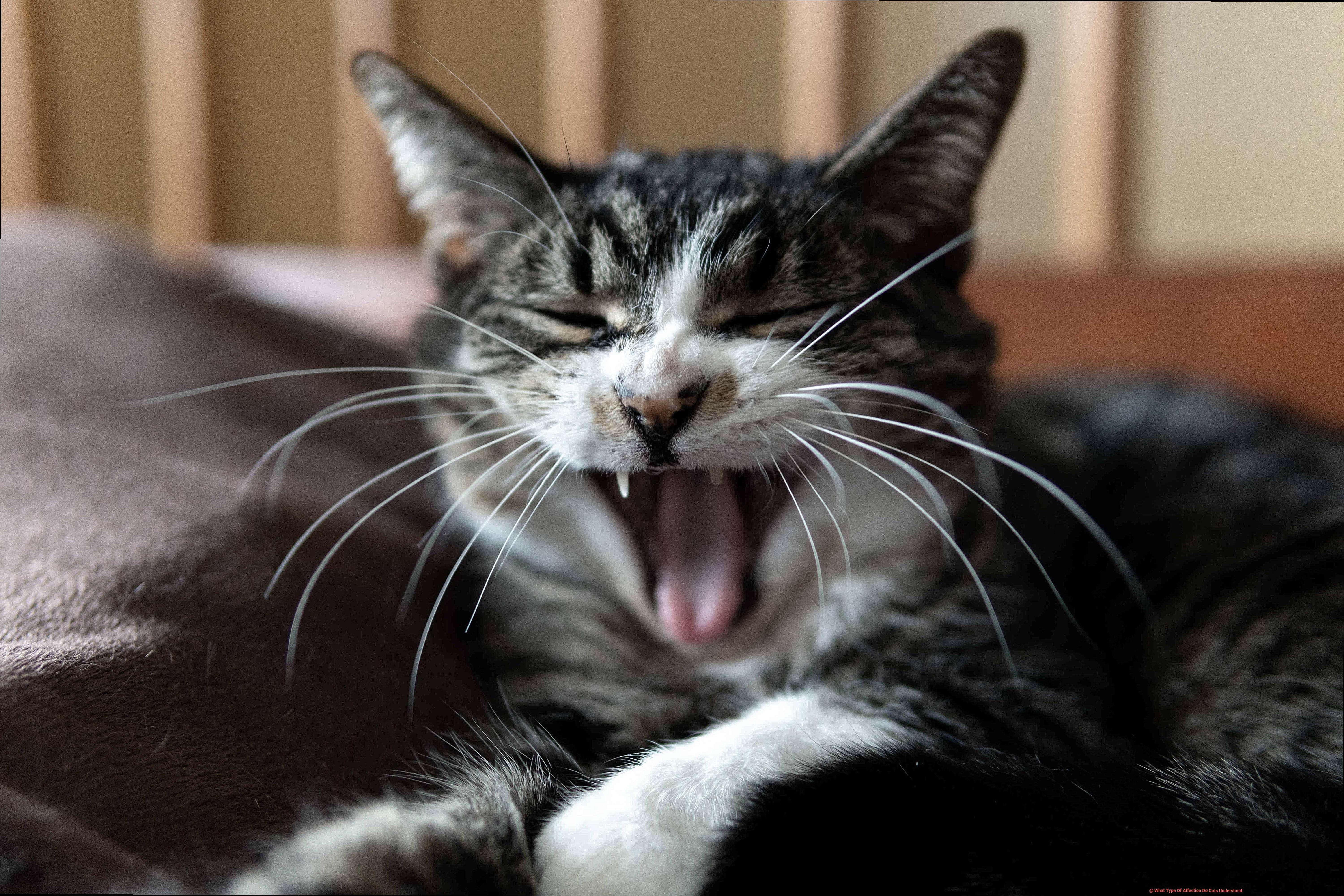Do you often feel like your cat just doesn’t get you? As a cat parent, it’s not uncommon to wonder whether your feline friend truly understands the love and affection you show them. But fear not, fellow cat lovers – as an expert on all things feline, I’m here to shed some light on the subject.
Cats may have a reputation for being aloof and independent, but that doesn’t mean they don’t crave affection. They just have their own unique way of showing and receiving it. Unlike dogs who are happy to receive constant physical attention from their humans, cats prefer to dictate the amount and type of affection they receive.
So what types of affection do cats actually understand? In this blog post, we’ll explore the various ways in which cats seek and enjoy affection – from physical touch to vocal communication and mental stimulation. We’ll also dive into why each type of affection is important to them and how you can properly show your furry friend the love they need.
Whether you’re a seasoned cat parent or a newbie looking to deepen your bond with your feline companion, this post will provide valuable insights on how to communicate with your kitty effectively through affection. So grab a cup of tea (or catnip tea if that’s more your style) and get ready to learn all about the fascinating world of feline affection.
Understanding a Cat’s Natural Behavior

Cats are fascinating creatures with unique communication methods that set them apart from other animals. To truly understand what kind of affection cats respond to, we must first understand their natural behavior.

As instinctive animals, cats are territorial by nature. They thrive on routine and consistency, preferring a predictable environment. Their natural hunting instincts can be seen in the way they play, pounce, and enjoy interactive toys like laser pointers and feather wands.
Cats also have a keen sense of smell and use scent marking to communicate with other cats and mark their territory. Scratching is not only a way for them to maintain their claws but also a means of leaving their scent behind.
In addition to scent marking, cats use body language and vocalizations to express their emotions. Owners who pay attention to their cat’s body language can tell whether they are receptive to affection or not. A purring cat rubbing against your leg is a clear sign that they are enjoying your attention, while pinned-back ears or tail twitching could indicate discomfort.
Vocalizations are another way cats communicate, using a range of sounds to express different emotions. Talking to your cat in a soothing voice can help build that special bond between you both.
Understanding a cat’s natural behavior is fundamental in creating a strong bond with them. By providing an environment that meets their needs and natural instincts, they will feel more comfortable and secure in your home.
So, what kind of affection do cats appreciate? They respond well to physical touch, verbal communication, and playtime. Providing them with scratching posts and interactive toys satisfies their natural instincts and helps them feel content and happy in your home.
Physical Touch: Petting and Stroking
Without a doubt, physical touch, such as petting and stroking, is one of the most common ways we express our love. But did you know that not all cats enjoy being touched in the same way? Each cat has their own unique preferences and boundaries when it comes to physical touch.
To ensure that you’re giving your cat the right type of physical touch, there are a few things you need to keep in mind. Firstly, cats are not small dogs. They have different sensory systems and social structures, which means they may not interpret touch in the same way. While some cats may enjoy being petted and stroked for long periods, others may become agitated or anxious if touched for too long or in the wrong way.
To make sure your cat is enjoying their cuddles, pay attention to their body language and vocalizations. Signs that your cat is happy include purring, kneading with their paws, and leaning into your hand. If your cat flattens their ears, twitches their tail, or tries to move away from you, it’s a sign that they’ve had enough.
It’s also important to consider where your cat likes to be touched. Some cats enjoy being petted on the head and chin, while others prefer gentle strokes along their back or under their chin. Experimenting with different types of touch can help you find what works best for your cat.
Here are some dos and don’ts when it comes to physical touch:
DO:
- Pay attention to your cat’s body language and vocalizations
- Experiment with different types of touch
- Respect your cat’s boundaries
DON’T:
- Force your cat to be touched if they don’t want it
- Assume all cats like the same type of touch
- Overstimulate your cat with too much touch
Verbal Communication: Talking to Your Cat
While cats cannot speak human languages, they are skilled at interpreting the tone and pitch of our voices. Verbal communication can be an effective way to communicate with your cat, as long as you use the right approach.
First and foremost, it’s important to use a calm and soothing tone of voice when speaking to your cat. Yelling or raising your voice can cause them to become frightened or anxious. Instead, try speaking in a soft and gentle voice to create a calming environment for your feline friend. Remember that cats are sensitive to loud and harsh sounds, so keep it chill.
Using specific words and phrases is another crucial aspect of communicating verbally with your cat. While they may not understand the exact meaning of words, cats can learn to associate certain phrases with specific actions or behaviors. For instance, consistently saying “time for dinner” before feeding your cat can help them recognize that phrase as an indication that food is on its way. Repetition is key here.
It’s also important to pay close attention to your cat’s body language when communicating verbally. Cats communicate through their posture, facial expressions, and vocalizations, so it’s essential to be aware of these cues when interacting with them. If your cat appears anxious or uncomfortable while you’re talking to them, it may be time to switch to non-verbal forms of communication like petting or playing.
Verbal communication can be an effective way to strengthen the bond between you and your furry friend. By speaking calmly and using specific phrases consistently, you can help your cat understand what you’re trying to convey. Just remember to pay attention to their cues and adjust your communication style accordingly. With a little practice, you’ll be talking to your cat like a pro in no time.
Playtime: Satisfying Their Instincts
As natural hunters, cats have an instinctual need to stalk, pounce, and chase prey. Playtime provides the perfect outlet for these innate behaviors and helps them maintain a healthy and happy life.
Playtime has numerous benefits for cats, both physical and mental. It helps them relieve stress, burn calories, and develop their muscles and coordination skills. When cats play, they release pent-up energy and aggression, which prevents destructive behavior like scratching furniture or biting. Moreover, playtime is an excellent way to bond with your furry friend, and it provides a sense of security and comfort.
When it comes to playtime, it’s important to observe your cat’s behavior and provide them with toys that suit their personality. Some cats prefer chasing toys that resemble prey, while others enjoy batting around toys that make noise. Interactive toys like wand toys or laser pointers are great for engaging your cat in playtime and providing them with the exercise they need.
The duration and frequency of play sessions are also crucial for your cat’s well-being. It’s best to keep play sessions short and frequent throughout the day since cats have short attention spans. A few 10-15 minute play sessions spread out over the day are more effective than one long session.
It’s also essential to ensure that playtime is safe for your cat. Avoid using toys with small parts that can be swallowed or strings that can become tangled around their necks. Always supervise your cat during playtime to prevent accidents or injuries.
Respect Their Boundaries
Unlike dogs who are often referred to as “man’s best friend,” cats are known for their independent and sometimes aloof nature.
It’s crucial to respect your cat’s boundaries if you want to build a healthy and trusting relationship with them. Here are some reasons why:
Firstly, forced physical affection can lead to stress and anxiety in cats. While some cats may enjoy being petted or scratched, others may find it overwhelming or even painful. As a result, it’s important to be mindful of how your cat reacts when you try to show them affection. If they seem uncomfortable or tense, it’s best to back off and give them space.
Secondly, cats have different preferences when it comes to physical touch. Just like humans, each cat is unique and has their own set of likes and dislikes. Some cats may enjoy being petted or scratched in certain areas, while others may prefer to be left alone altogether. It’s important to pay attention to your cat’s cues and respect their preferences.
Lastly, cats need their space. Cats are independent creatures and often require time alone to recharge. If your cat retreats to a hiding spot or chooses not to interact with you, it’s important to give them the space they need and avoid forcing interaction.
Respecting your cat’s boundaries is the key to building a strong and loving relationship with your feline companion. By reading their body language and responding accordingly, you can ensure that your cat feels comfortable and safe in your presence.
Remember, playtime and affection are important aspects of a cat’s life, but it’s important to do it on their terms. Here are some tips for showing affection to your cat while respecting their boundaries:
- Observe your cat’s body language and be mindful of their reactions.
- Try different forms of affection, such as playing with toys or offering treats.
- Give your cat space when they need it, and don’t force interaction.
- Respect your cat’s preferences when it comes to physical touch.
Different Types of Affection for Different Cats
However, not all cats respond to the same types of affection. As a cat owner, it’s important to understand and provide the right kind of affection that your feline friend enjoys. Here are five different types of affection that cats can appreciate and how to show them:
Physical Touch
Cats love to be petted and cuddled, but it’s important to approach them gently and respect their personal space. Some cats may prefer being scratched behind the ears or under the chin while others enjoy belly rubs. Observing your cat’s body language is crucial in understanding what they like and don’t like.
Verbal Communication
Cats respond well to positive reinforcement in the form of praise and compliments. Talking to your cat in a soft voice, using their name, and expressing your love for them can make them feel secure and loved. Some cats even enjoy having conversations with their owners.
Playtime
Playing with your cat is not only fun but also helps create a bond between you and your feline friend. Toys such as feather wands, laser pointers, or balls can provide mental stimulation and satisfy their natural hunting instincts. Engaging in interactive playtime can also help alleviate boredom and stress.
Treats
Giving your cat occasional treats is a way to show affection and make them feel appreciated. However, it’s important to be mindful of overfeeding as obesity and other health issues can occur. Treats should be given in moderation and as part of a balanced diet.
Comfortable Environment
Providing a comfortable and safe environment for your cat is a form of affection that ensures their overall well-being. This includes providing plenty of space for them to play and explore, cozy spots for napping, and regular veterinary checkups to maintain their health.
Tips for Building a Bond with Your Cat
Cats are known for their independence and can sometimes seem aloof, but they still crave love and attention from their owners. Building a strong bond with your feline friend not only benefits them, but it also creates a happier and more fulfilling relationship for you. Here are five tips on how to establish a close connection with your cat.
Engage in Playtime
Playing with your cat is an excellent way to bond with them, as it allows them to express their natural hunting instincts. Interactive toys such as feather wands or laser pointers can provide endless entertainment for your furry friend, while also giving you the opportunity to bond through play.
Provide Comfortable Spaces
Cats are territorial creatures and need their own space to feel secure. Providing them with a comfortable bed, scratching post, and designated play area can help them feel at ease in their environment. This gives your cat the security they need to relax and be themselves around you.
Spend Quality Time Together
Spending quality time with your cat is crucial in building a strong bond. Whether it’s grooming sessions, cuddling, or just sitting quietly together, these moments of connection will help foster trust and affection between you and your furry companion.
Respect Their Boundaries
It’s essential to understand and respect your cat’s boundaries when building a bond. Some cats may enjoy being held or petted, while others may prefer to be left alone. Paying attention to their body language will help you determine what type of affection they appreciate and what makes them uncomfortable.
Use Positive Reinforcement
Positive reinforcement is an excellent way to build trust and reinforce good behavior in your cat. Rewarding them with treats or praise when they exhibit positive actions like using the litter box or playing nice will encourage them to continue these behaviors.
Conclusion
In conclusion, while cats may have a reputation for being independent creatures, they still crave affection from their owners. As a responsible cat parent, it’s essential to comprehend the types of affection that cats respond to and how to show them effectively. Unlike dogs who love constant physical attention, cats prefer to dictate the amount and type of affection they receive.
To form a strong bond with your feline companion, it’s imperative to understand their natural behavior. Cats communicate through body language, vocalizations, and scent marking. They also have an instinctual need to stalk, pounce and chase prey, making playtime an integral aspect of their lives.
Cats respond positively to physical touch like gentle petting and stroking. Verbal communication in a soothing tone of voice using specific phrases consistently can also be effective in showing your furry friend affection. Additionally, interactive toys that satisfy their natural instincts are an excellent way to engage with your cat.
It’s crucial to respect your cat’s boundaries when showing affection as forced physical contact can lead to stress and anxiety in cats. Building a strong bond with your feline companion requires engaging in playtime, providing comfortable spaces for them, spending quality time together while respecting their preferences and using positive reinforcement.
By understanding what kind of affection your cat responds well to and respecting their preferences, you can create a happier and more fulfilling relationship with your furry friend.







